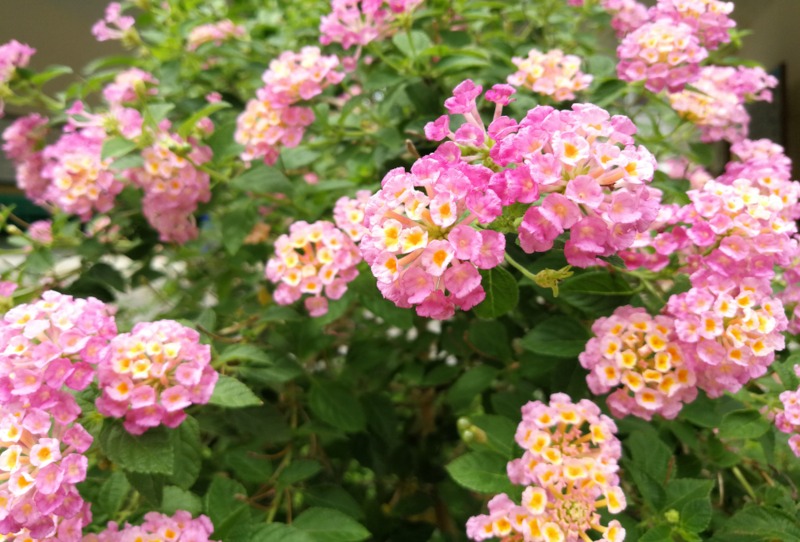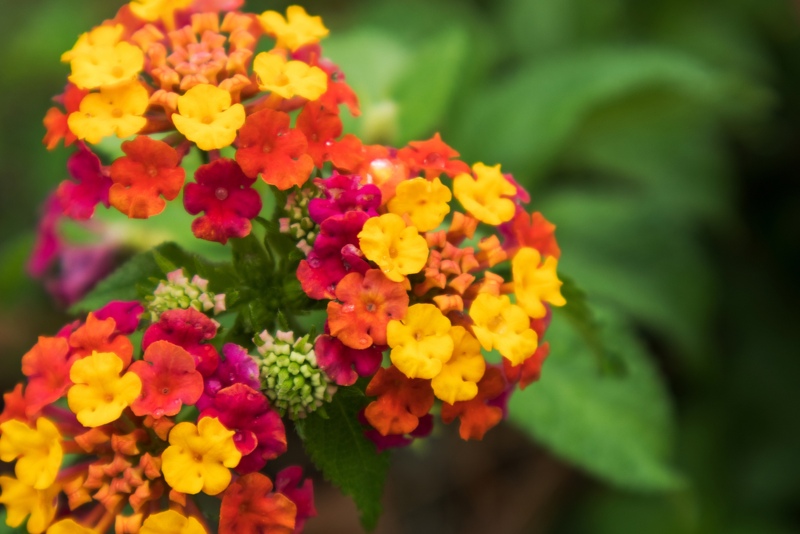
Lantana is a genus of the verbena family, made up of over 150 bright and colorful perennial flowering plant species. This plant is characterized by its small, round clusters of flowers that grow in various colors, like red, orange, yellow, white, pink, and purple.
Lantana is an invasive species to tropical areas that don’t have frost seasons, like Florida and Hawaii. Its scent is similar to fermented citrus or gasoline. It thrives in warm, tropical climates and loves the sun. The plant also tolerates salt exposure very well.
If you live in a more temperate climate, lantanas are most often planted in hanging pots and will die in the winter. If you want to grow your lantana as a perennial and live in a temperate area, then you can bring your lantana inside for the winter.
This plant will not thrive and flower in indoor conditions, but it will enter a state of dormancy. During its dormancy, it’s best to give the plant as little light and water as it can survive on.
Lantana is native to South and Central America. If you live somewhere that it’s warm year-round, lantana is perennial. Lantana will enter a dormant state, but the flowers will come back year after year.

| Botanical Name: | Lantana camara |
| Common Name(s): | Lantana, shrub verbena |
| Plant Type: | Perennial in zones 8-11, annual in others |
| Mature Size: | 6-feet tall |
| Sun Exposure: | Full sun or partial shade |
| Water Needs: | In young plants, keep the soil moist. In established plants, one inch of water per week will suffice |
| Soil Type: | Well-drained |
| Soil pH: | Mildly acidic, pH of 5.5-6.5 |
| Bloom Time: | Year-round |
| Maintenance: | Low maintenance |
| Flower Color: | Red, orange, yellow, white, pink, and purple. It can be bi-colored or multicolored. |
| Hardiness Zones: | 8-11 |
| Toxicity: | Toxic to pets, livestock, and humans |
Lantana Care
Lantanas are very easy to care for. They tolerate partial shade and full sun, and they can accept dry conditions. Read on for more specific information on lantanas.
Light
Lantana grows best in full sun. It can tolerate partial shade, but 6-8 hours of sun exposure is ideal. If grown in shadier spots, the plant will not flower as much.
Water
Lantana thrives when watered regularly. If lantana has been recently planted, you should water it frequently and not let the soil get completely dry. Established lantana can tolerate less moisture, needing only a couple of inches of water a week.
How frequently you water your lantana does affect the bloom rate. If you notice that your plant hasn’t been flowering as much lately, try watering it more.
Temperature
Lantana grows best in tropical and warm areas that never get below 55°F. Lantana may be able to survive a light frost, but regular below-freezing temperatures will kill the plant.
Soil
Lantana does well in almost any well-draining soil, even those with higher-than-normal sand content. The plant also prefers slightly acidic soil and thrives in soil with a pH of 5.5-6.5.
Fertilizer
Lantana is very low-maintenance and does not need fertilizer to flower better. Applying too much fertilizer can prevent the plant from producing a lot of flowers.
If you want to fertilize your lantana, you can give a small amount in early spring or use a 20-20-20 fertilizer monthly.
Toxicity
Lantana is poisonous to almost all livestock, pets, and humans. All parts of the plant contain triterpenoids or liver toxins.
Ingesting the berries, flowers, or leaves can be severely harmful and fatal to animals. Consuming the plant can also cause gastrointestinal discomfort in adult humans. It is best to keep this plant in a high place, away from pets and children.

Propagation
You can propagate lantana in one of two ways: cuttings or seeds.
Propagating lantana from cuttings is very easy and will produce an offspring plant identical to the parent plant. Since most lantanas are hybrids, growing from seed will likely produce an offspring plant that looks much different from the parent plant.
Taking a cutting of lantana is very simple. All you need to do is:
- Take approximately a 4-inch section of the stem and remove the leaves from the bottom half.
- You can place the cutting in water to develop roots, or you can plant the cutting into a small pot with damp soil.
- You can use a rooting hormone if you wish, but it’s not required.
- Keep the soil moist, and transplant the cutting either into the ground or into a larger pot once it starts to outgrow the one it’s in.
If you plan on growing from seeds, you should start them at least six weeks before you plan to transplant them outside.
You can use any starting soil mix to start lantana. Soak your seeds for up to 24 hours to soften the hard seed coat. Then, plant the seeds in individual pots and cover them with about 1/8 inch of soil.
Keep the soil damp, and transplant into larger pots or the ground once the lantana is large enough and the weather is warm enough.

Deadheading and Pruning
Deadheading lantana can help the plant produce flowers more abundantly, but it’s unnecessary if you prefer fewer blooms. Pruning is also excessive, but if you decide to prune your lantana, you should prune the plant to ⅓ its size.






